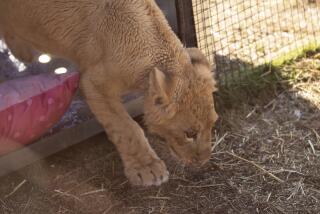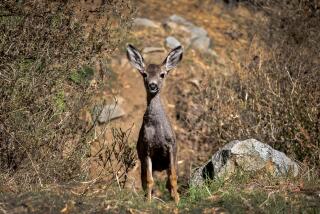Plan to cull elephants unveiled
JOHANNESBURG, SOUTH AFRICA — Small farmers and villagers here see them as cunning, destructive and dangerous beasts whose very name conjures up death. In the West, elephants are perhaps the most beloved of the big game species and tourists fly thousands of miles just to see one.
So South Africa’s proposal, unveiled Wednesday, to thin elephant herds by methods that include shooting them was bound to spark controversy.
Regulations announced by South African Environmental Affairs Minister Marthinus van Schalkwyk would affect thousands of elephants. Strategies would include contraception, aerial sharpshooting and relocation to reduce the herds to manageable levels.
Contraception methods include drugs delivered by dart to female elephants and vasectomies for males.
“Some [methods], such as culling or contraception, I would personally have preferred not to consider, but I am persuaded that this option has a potential role to play under different circumstances,” Van Schalkwyk said. He said the regulations, if approved, would not lead to wholesale elephant slaughter.
“Where lethal measures are necessary to manage an elephant or a group of elephants or to manage the size of elephant populations, these should be undertaken with circumspection,” he said, adding that each national park would set its own wildlife management plan.
Alarmed at a pachyderm population that has swelled to 20,000, South African authorities have been weighing the issue since 2005, amid warnings that shooting elephants in national parks could trigger angry campaigns by animal rights groups, damage South Africa’s international reputation or spark a tourism boycott.
The government has not released any estimate on the number of elephants that could be affected.
Since 1995, the elephant population in Kruger National Park, in northeastern South Africa, has grown from about 8,000, considered manageable, to almost 14,000.
Authorities have cautioned against assuming that herds would be culled based on those figures.
South Africa slaughtered more than 14,500 elephants from 1967 to 1994 but stopped amid international pressure. The government is allowing about two months for public commentary before finalizing its decision on how to manage the herds.
Elephants eat 300 to 600 pounds of grasses and leaves a day.
They wreak havoc on fragile landscapes, uprooting trees or tearing off branches for food. In some southern African countries such as Zambia, they trample crops and attack villagers, killing several each year.
Elephant populations in Africa plummeted sharply in the 1970s and ‘80s because of ivory poaching. But they bounced back after an international ban on ivory trade was imposed in 1989.
An estimated 250,000 to 300,000 elephants now live in southern Africa.
Highly intelligent creatures that can live 60 to 70 years, elephants have long fascinated researchers and laymen alike. They live in highly complex matriarchal family groups.
Groups such as the International Fund for Animal Welfare argue that slaughtering elephants is “a cruel, unethical and scientifically unsound practice.”
Sharpshooters in helicopters normally kill entire family groups, including the calves, because of the complex social structures and the role elder matriarchs play in educating young elephants in survival and socialization.
Dr. Susan Lieberman, global species director for the World Wildlife Fund, said in a telephone interview that the fund did not recommend culling and called on the South African government to thoroughly explore all the alternatives.
“There are a lot of complexities, and our sense is that the South African government is taking that into consideration. You have to explore all the alternatives, such as looking at transportation and expanding their range, contraception and all other options.
“If their range really is too small and if elephants are destroying habitat and will eventually harm themselves and endangered species, then maybe it’s the only management option.
“Nobody wants to do this. From a wildlife management point of view, you have to look at the whole ecosystem,” she said.
Lieberman said there had been cases of successful elephant contraception, “but it’s extremely difficult, and it’s extremely expensive.”
*
More to Read
Sign up for Essential California
The most important California stories and recommendations in your inbox every morning.
You may occasionally receive promotional content from the Los Angeles Times.









